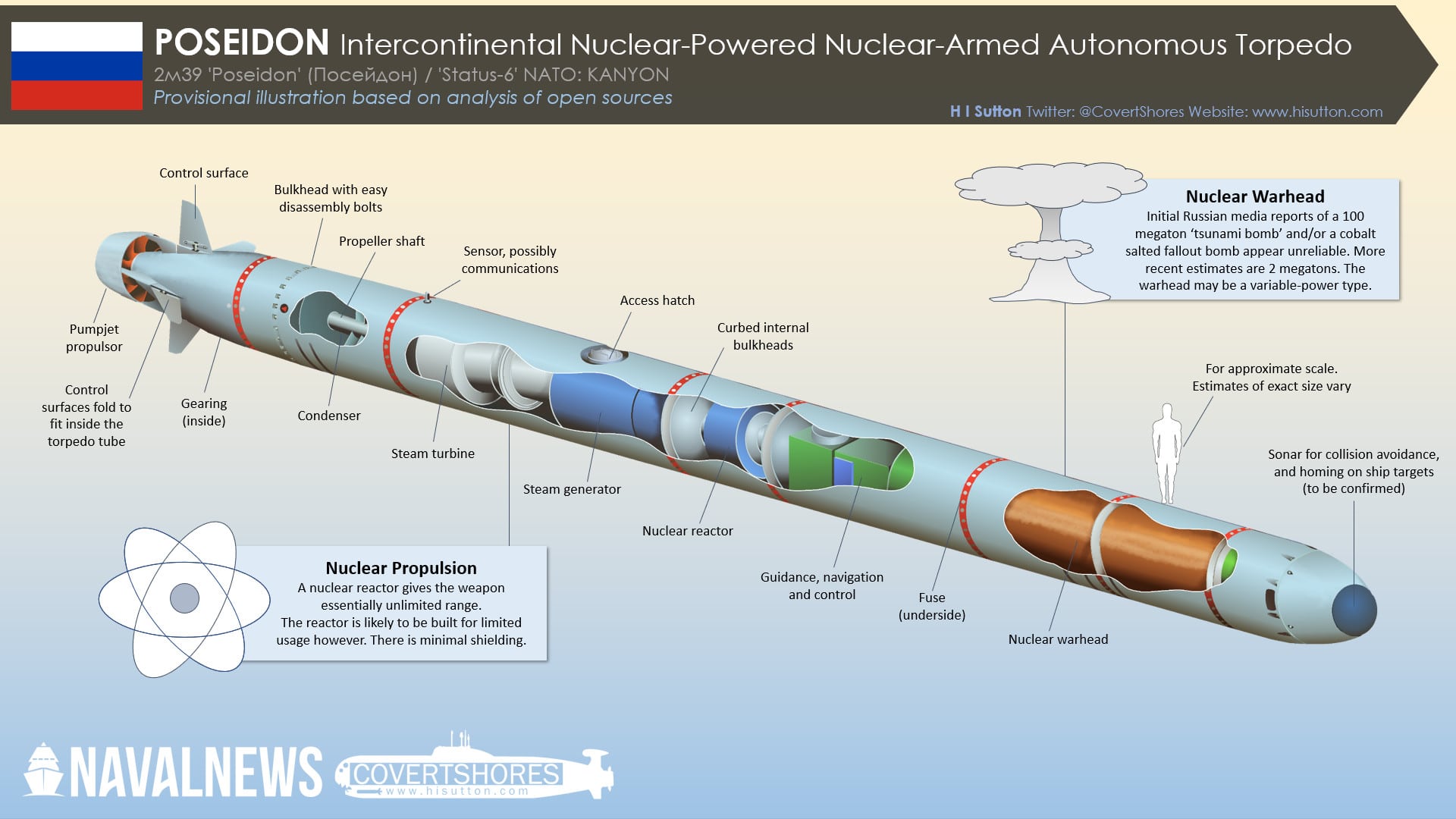Russia’s New ‘Poseidon’ Super-Weapon
As Russia ratchets up the nuclear threat over the past few days, following their invasion of Ukraine, one of the weapons on people’s minds is Poseidon. This nuclear ‘mega torpedo’ is unique in the history of the world.
Despite speculation, we do not believe that Poseidon has been deployed. The system is not yet ready. But it does raise concerns for nuclear stability in the near future. It changes the shape of nuclear deterrence and will become one of Russia’s most feared weapons.
Poseidon is an ‘Intercontinental Nuclear-Powered Nuclear-Armed Autonomous Torpedo’. It is a giant torpedo which can hit coastal cities with devastating results. Compared to an intercontinental ballistic missile it is very slow, but possibly unstoppable.
Russia maintains that it can also be used as a tactical nuclear weapon against warships. High-value targets would include aircraft carriers. This is harder to rationalize than the second-strike nuclear deterrence role, but it is a constant theme. Ever since it was first revealed in November 2015, then known as Status-6. it has been described as a multirole system.
The weapon’s expected speed, around 70 knots, is fast enough to make it realistically uncatchable to existing torpedoes. And its operating depths, perhaps as deep as 1,000 meters (3,300 feet) puts it beyond reach. Western planners will have to develop new weapons to intercept it. And that will take considerable time and investment.
A nuclear reactor gives the weapon essentially unlimited range. This gives it new levels of operational flexibility in terms of launch and target locations. Although it is restricted to at-sea or coastal targets, such as New York, Los Angeles. It can be launched from under the protection of the ice cap, or from coastal waters.
In reality the reactor is likely to be built for limited usage however. It does not appear that it is intended for sustained use, which will shape the way it can be used. This fits with it being a weapon, shot in anger. rather than a prototypical underwater drone.
Although the weapon is large, we estimate in the region of 100 tons, it is still small by nuclear submarine standards. It uses direct drive from the steam turbine, via gearing, to the pumpjet. The small diameter does not appear to allow for any significant quietening so the craft will not be particularly stealthy. Additionally there is minimal shielding so it may leave a trail of radiopacity. This could be a factor in tracking it, especially during trails.
The shielding also raises the that the reactor would not be run while the weapon is aboard the submarine. This would require additional shielding to protect the crew.
Myths And Misconceptions About Poseidon
Perhaps because so little is known about the weapon there has been a lot of speculation. And because it is a completely new category of weapon there is no previous system to borrow interpretations from. This contributes to popular misconceptions. However we have been following development since before 2015 and have narrowed down many aspects.
The system is not a direct development of the unbuilt T-15 mega-torpedo from the 1950s. That was a weapon some Russian planners expected to be carried by submarines to attack ports. It had a nuclear warhead but regular propulsion, meaning that it was quite short ranged. Which similar in scale and armament, the two are separated by both years and doctrine.
Poseidon is a weapon. Although its incredible range requires autonomy, it is not a drone in the same sense as other uncrewed underwater vehicles. There are no signs of buoyancy control or surveillance systems, so it is not an intelligence asset.
Another myth is that it is supercavitating, like the famous VA-111 Shkval torpedo. This would allow it to travel extremely fast, at over 100 knots. Supercavitation works by creating bubbles at the nose and then riding inside the bubble created to reduce friction. These weapons require rocket propulsion and extra-large control surfaces which must be outside the bubble. Poseidon has none of this.
And it is designed to be carried by a submarine in a sealed tube. These submarines are incredibly expensive and are a massive investment for the Russian Navy. This suggests that it is not designed to be forward-deployed as a mine, waiting to detonate in an enemy port.
Initial Russian media reports of a 100 megaton ‘tsunami bomb’ and/or a cobalt salted fallout bomb appear unreliable. More recent estimates are 2 megatons. The warhead may be a variable-power type.
Poseidon’s Day Will Come
Poseidon is a completely new category of weapon. It will reshape naval planning in both Russia and the West, leading to new requirements and new counter-weapons. A weapon which cannot be nullified with anti-missile defenses. In future nuclear tensions, if we live through this one, it will be a strong factor.
But we are not there yet. As of today none of the submarines to carry it are operational. One test submarine, Sarov which can carry a single round, is in service. Another boat, Belgorod, is not yet commissioned. It could be speculated that Russia could attempt a launch if desperate enough. But it is currently nowhere near the threat level of traditional submarine launched missiles.
copied by Naval News.

Comments
Post a Comment